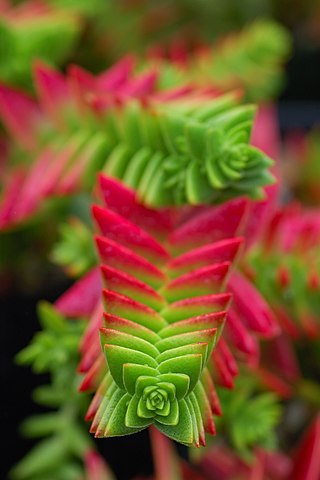
Crassula is a genus of succulent plants containing about 200 accepted species, including the popular jade plant. They are members of the stonecrop family (Crassulaceae) and are native to many parts of the globe, but cultivated varieties originate almost exclusively from species from the Eastern Cape of South Africa.

Noccaea caerulescens, the alpine penny-cress or alpine pennygrass, is a flowering plant in the family Brassicaceae. It is found in Scandinavia and Europe.
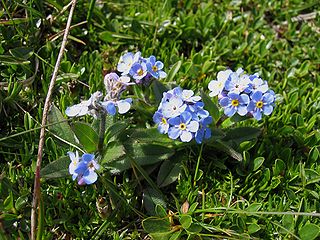
Myosotis alpestris or alpine forget-me-not is a herbaceous perennial plant in the flowering plant family Boraginaceae. The alpine forget-me-not is the county flower of Westmorland in the United Kingdom.

Microseris is a genus of plants in the tribe Cichorieae within the family Asteraceae, plants that often called composites. They are native to North America, South America, Australia, and New Zealand.
Metallotolerants are extremophile organisms that are able to survive in environments with a high concentration of dissolved heavy metals. They can be found in environments containing arsenic, cadmium, copper, and zinc. Known metallotolerants include Ferroplasma sp. and Cupriavidus metallidurans.
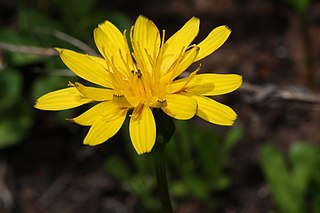
Nothocalais is a genus of North American flowering plants in the tribe Cichorieae within the family Asteraceae. There are known generally as false dandelions or false agoseris.
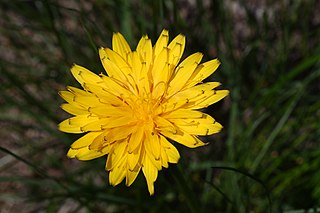
Nothocalais alpestris is a species of flowering plant in the family Asteraceae known by the common name alpine lake false dandelion. It is native to the Cascade Range, Sierra Nevada and other mountains from northern Washington to central California, where it grows in subalpine forests and meadows, most commonly at 1,200–2,700 m (4,000–9,000 ft) elevation.

Goodenia hederacea, commonly known as forest goodenia or ivy goodenia, is a species of flowering plant that is endemic to eastern Australia. It is a prostrate to ascending, perennial herb with linear to elliptic or round leaves, and racemes of yellow flowers.
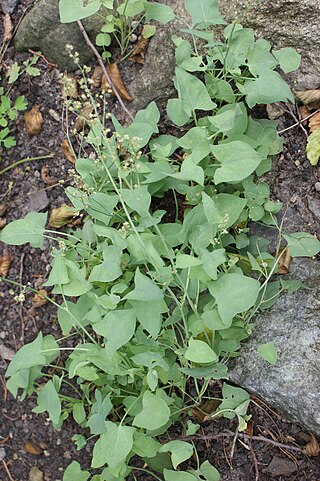
Rumex scutatus is a plant in the buckwheat family, used as a culinary herb. Its common names include French sorrel, buckler sorrel, shield-leaf sorrel, and sometimes the culinary name "green-sauce".

Thlaspi californicum is a rare species of flowering plant in the family Brassicaceae known by the common name Kneeland Prairie penny-cress. It is endemic to California, where it is known from only one stretch of grassland in Humboldt County. It is threatened by development. It is a federally listed endangered species of the United States.
Perrottetia alpestris subsp. philippinensis is a subspecies of Perrottetia alpestris. It is a plant in the family Dipentodontaceae, sometimes classified in the family Celastraceae.
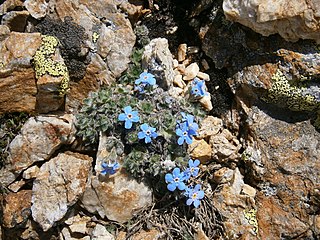
Alpine forget-me-not is a common name for several plants in the Boraginaceae (forget-me-not) family and may refer to:

Noccaea montana, the alpine pennycress, is a flowering plant in the family Brassicaceae. It is found in the Western United States. It has a basal rosette out of which grows "one or several short, unbranched stems that have small, arrow-shaped leaves and end in dense racemes of tiny white flowers."

Campanula alpestris, the alpine bellflower, is a species of flowering plant in the family Campanulaceae. It is native to the southwestern European Alps.

Polygala alpestris is a species of flowering plant in the milkwort family (Polygalaceae). It was described in 1823 and is found in Austria, France, Germany, Italy, Spain, Georgia, Turkey and Switzerland.

Noccaea is a problematic genus of flowering plants in the family Brassicaceae, native to temperate areas of western North America, southern South America, northern Africa, Europe and Asia.

Juncus alpinoarticulatus, called the northern green rush and the alpine rush, is a species of flowering plant in the genus Juncus, with a circumboreal distribution. It prefers wet sandy soils, peat bogs, acidic fens, and ditches.

Silene alpestris, the alpine catch-fly, is a species of flowering plant in the pink family Caryophyllaceae, native to Europe in the mountains of Italy, Austria, Slovenia and Croatia. This spreading, mat-forming evergreen perennial grows to 15 centimetres tall by 30 cm (12 in) broad. It produces masses of tiny white flowers over a long period in spring and summer.

Lactuca alpestris is a species of plant native to Crete in the Ida mountains and is a relative of lettuce.
Thlaspi alpestre may refer to two different plant species:

















